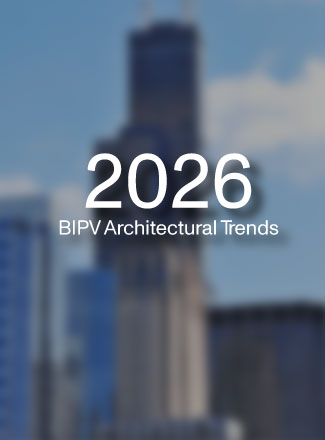
BIPV
October 20, 2023

The global energy landscape is undergoing a transformative change, driven by rapid urbanization, population growth, and the urgent need to combat climate change. As demand for energy continues to grow, it is paramount to find sustainable solutions that can cater to our modern lifestyles without further jeopardizing the planet. Building-Integrated Photovoltaics (such as BIPV facade) is emerging as one of the most promising solutions in this context.
The International Energy Agency predicts a significant increase in global energy consumption in the coming decades, primarily due to the growth of cities and the associated urban infrastructure. Buildings, both residential and commercial, are among the largest consumers of energy globally. As we build more to accommodate the growing population and urban centers, this consumption will only rise.
Traditional energy models centralize power production. BIPV facade decentralizes it, turning countless buildings into mini power plants. This distributed model can offset a significant portion of the energy demand, especially during peak daylight hours.
The energy lost during transmission from power plants to homes can be as high as 5%. With BIPV, power is generated where it's consumed, drastically reducing these losses.
Urban areas often lack the space for large solar farms. BIPV facade allows cities to harness solar energy without needing vast tracts of land.
With BIPV, as cities expand, so does the potential for energy generation. New buildings can be designed with a BIPV facade in mind, making the expansion of the energy network both organic and efficient.
BIPV systems not only reduce energy costs for building owners but also pave the way for a passive revenue stream, especially when excess energy is sold back to the grid. Their low maintenance requirements mean fewer expenses in the long run. Furthermore, in catastrophic events causing power outages, the BIPV facade acts as a reliable backup, preventing potential additional costs and ensuring uninterrupted power supply.
While BIPV holds great promise, its large-scale adoption requires collaborative efforts. Policymakers need to offer incentives, manufacturers must drive down costs, and the construction industry should be equipped with the skills and knowledge to implement BIPV effectively. In the quest to meet future energy demands sustainably, the BIPV facade represents a convergence of architecture and energy production. It's not just about constructing buildings anymore; it's about designing the future of energy.
News & Articles

This blog breaks down what project teams can expect when planning for Mitrex solar cladding installation. Based on standardized guidelines, we outline how project scope, system type, and sequencing all influence timelines — with a transparent look at estimated crew size, daily install rate, and duration.

This blog breaks down what project teams can expect when planning for Mitrex solar cladding installation. Based on standardized guidelines, we outline how project scope, system type, and sequencing all influence timelines — with a transparent look at estimated crew size, daily install rate, and duration.

Mitrex BIPV is engineered to match—and exceed—the lifespan of high-performance building envelope systems, delivering structural durability, long-term energy output, and measurable sustainability benefits. This article outlines the testing, certifications, and warranties behind solar facades designed to perform for decades across global climates and project types.

Mitrex BIPV is engineered to match—and exceed—the lifespan of high-performance building envelope systems, delivering structural durability, long-term energy output, and measurable sustainability benefits. This article outlines the testing, certifications, and warranties behind solar facades designed to perform for decades across global climates and project types.

Design-driven solar façades are the future—and in 2026, building-integrated photovoltaics (BIPV) must meet high architectural standards as well as performance benchmarks. This blog highlights five architectural design trends that are shaping next-generation BIPV applications and how Mitrex products—from custom murals to landmark towers—are making them a reality.

Design-driven solar façades are the future—and in 2026, building-integrated photovoltaics (BIPV) must meet high architectural standards as well as performance benchmarks. This blog highlights five architectural design trends that are shaping next-generation BIPV applications and how Mitrex products—from custom murals to landmark towers—are making them a reality.